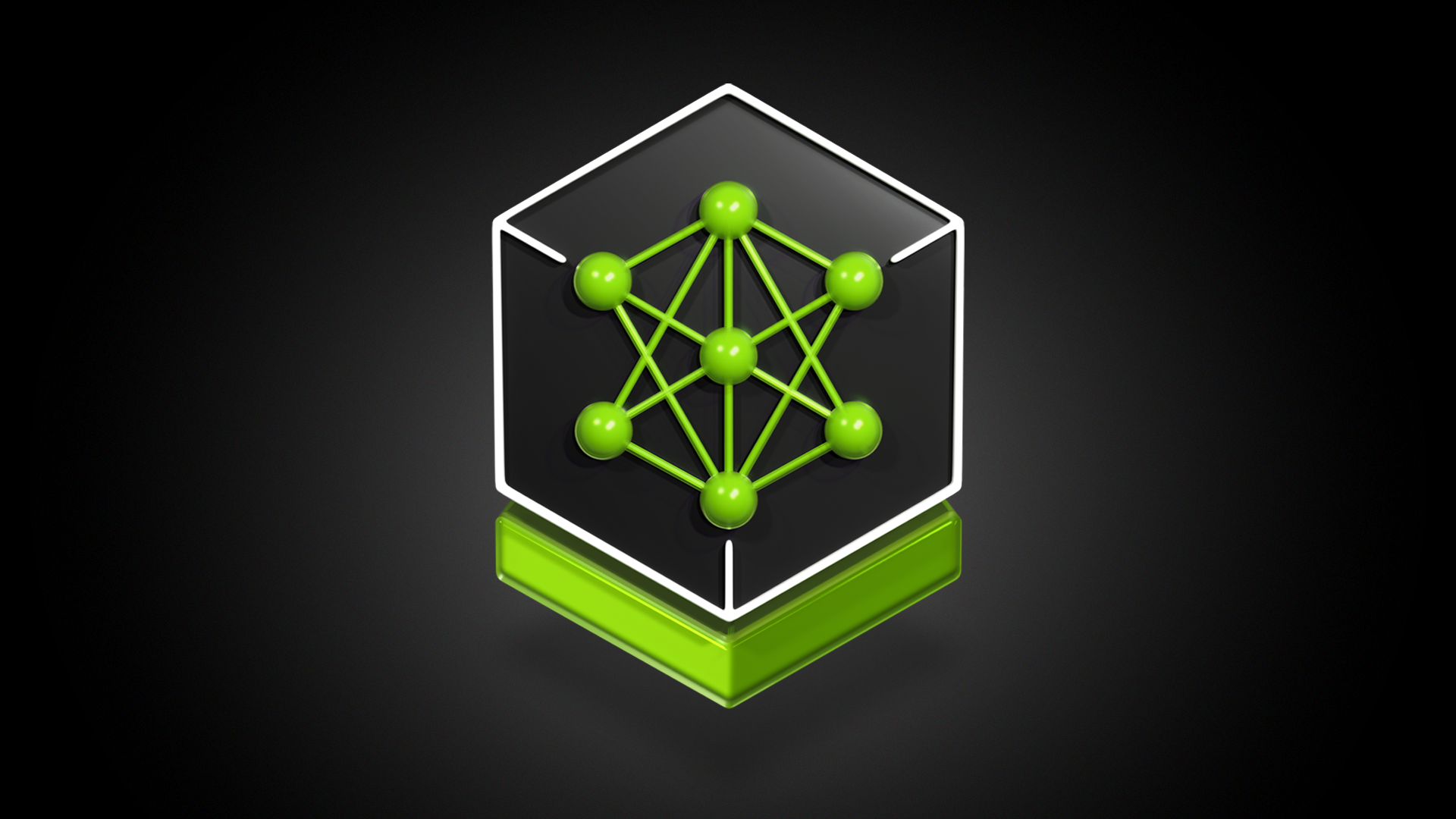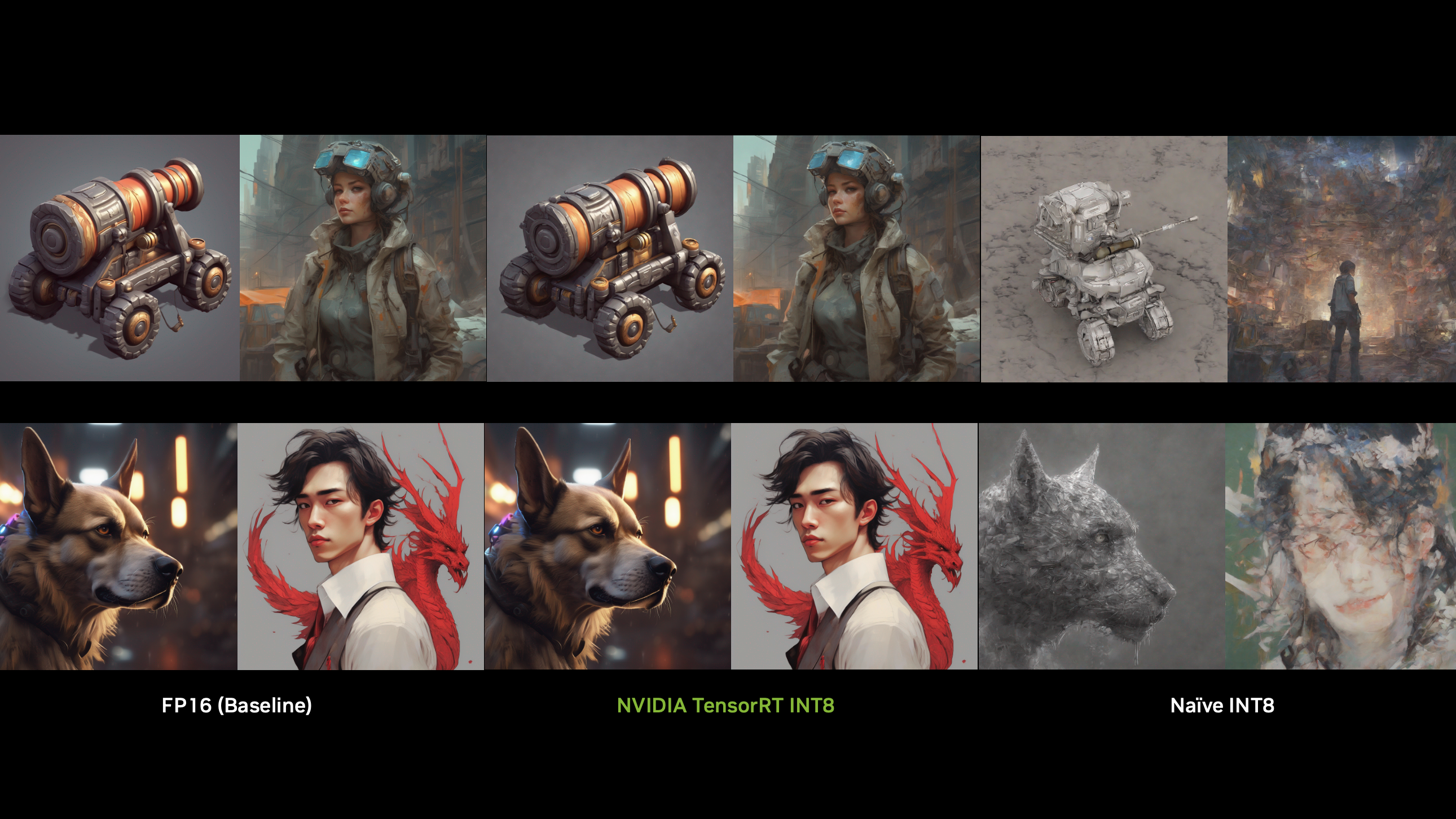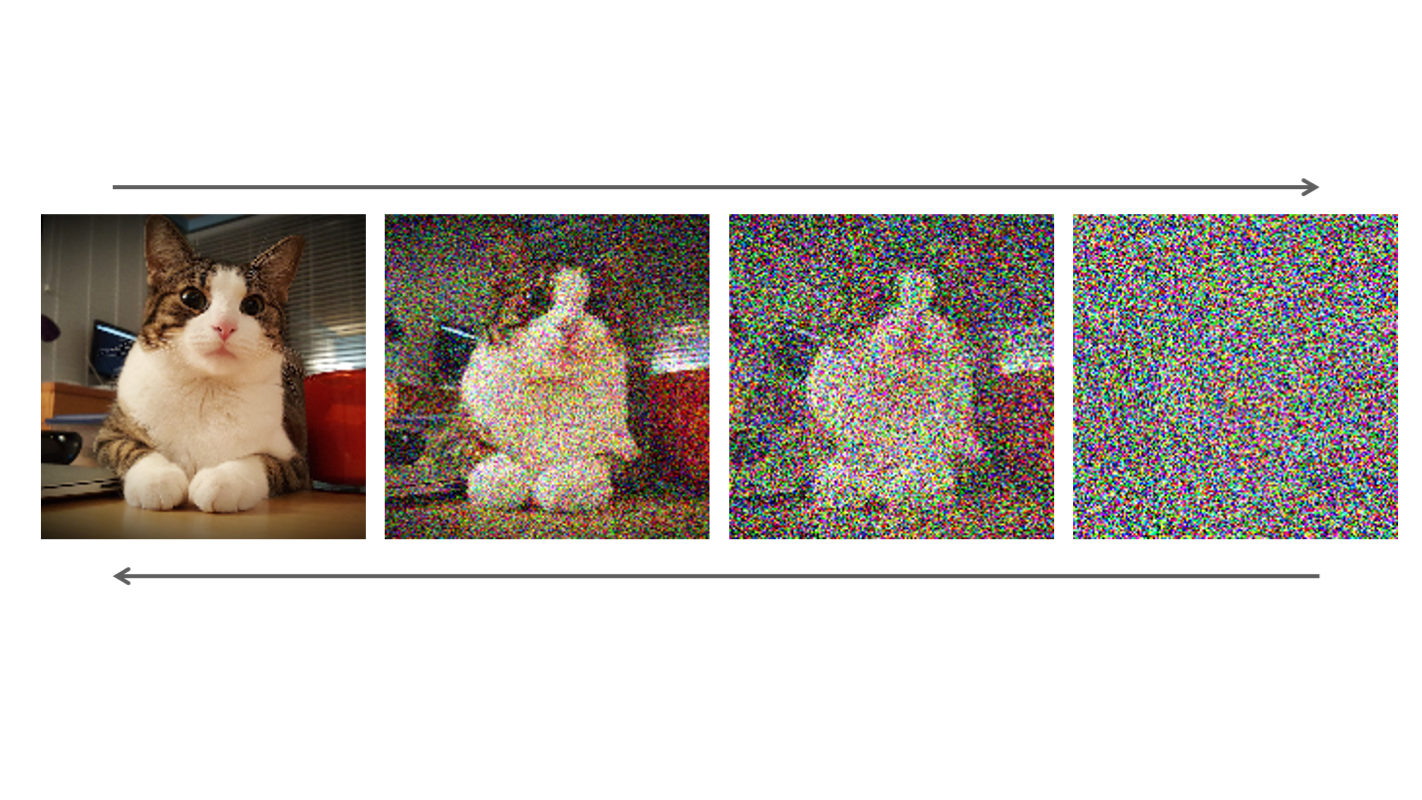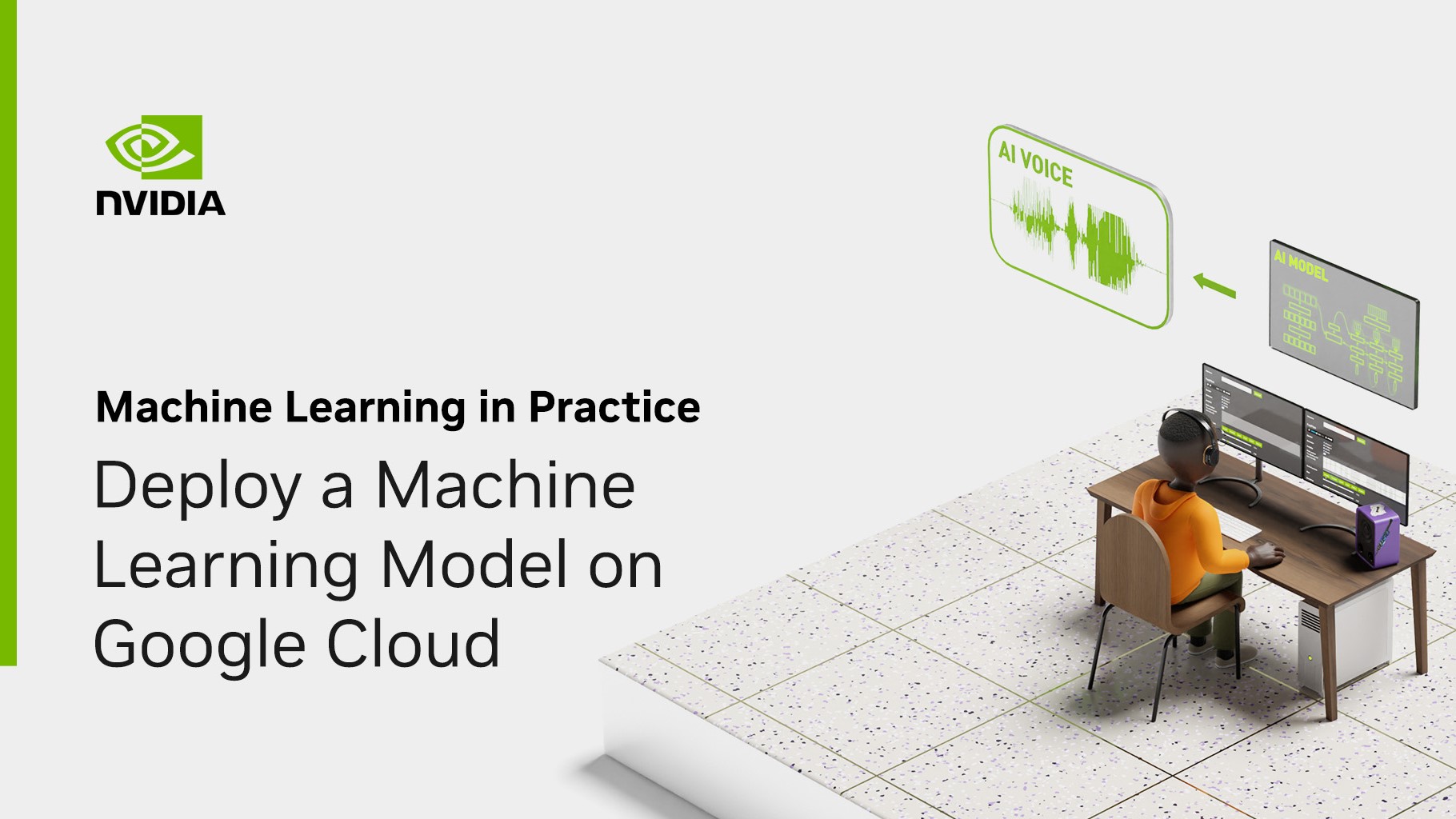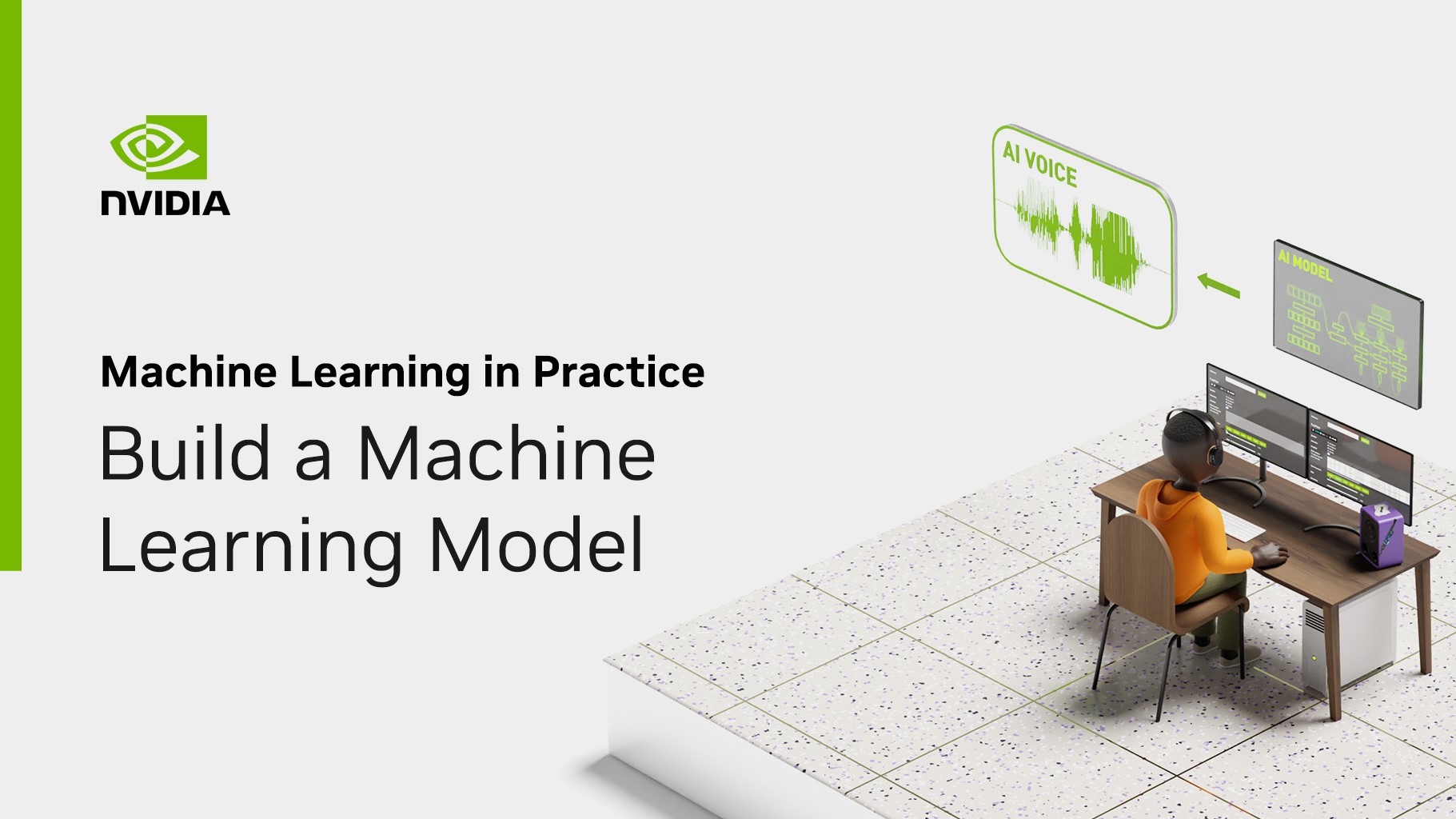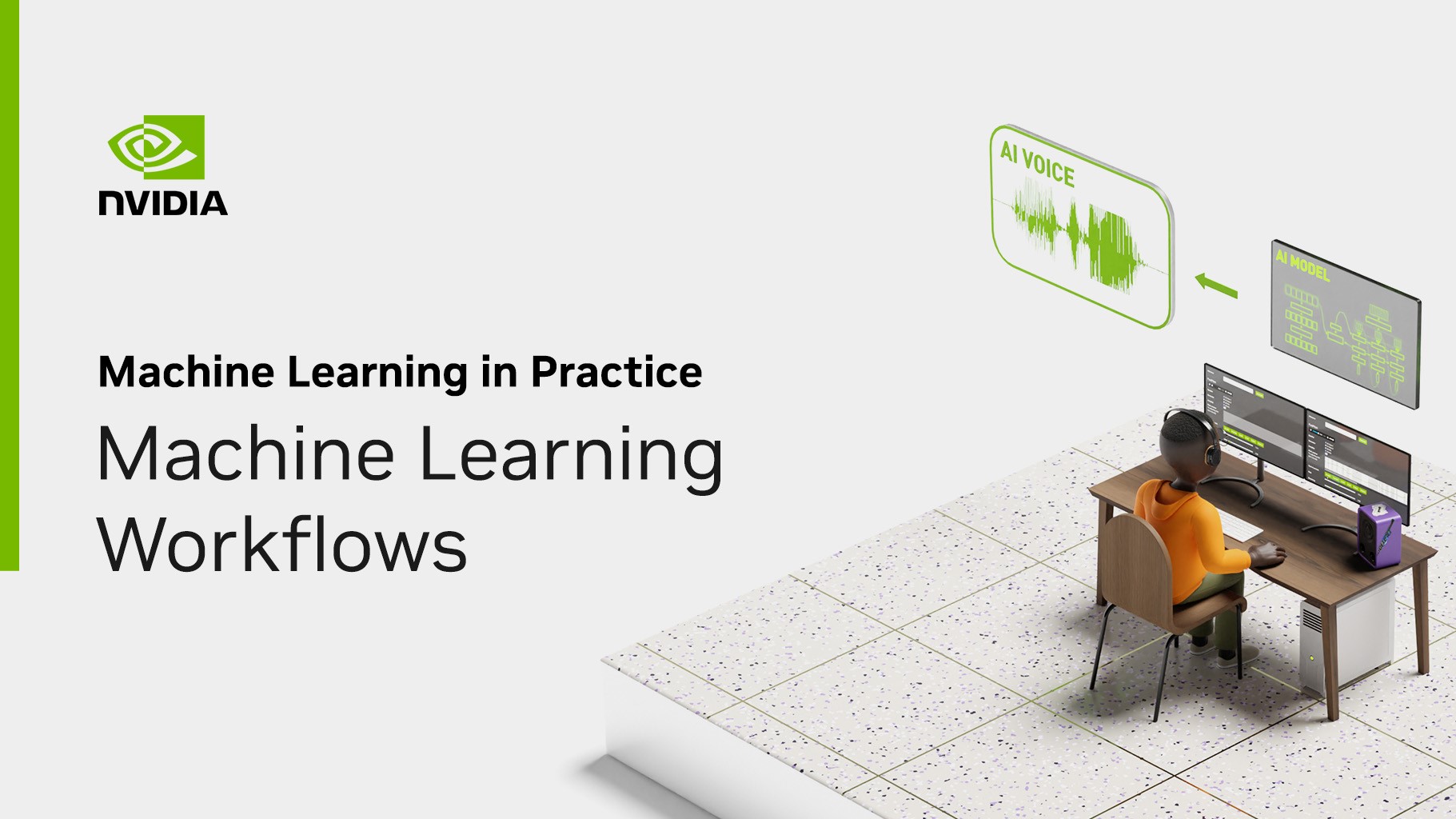Diffusion models are transforming creative workflows across industries. These models generate stunning images based on simple text or image inputs by iteratively shaping random noise into AI-generated art through denoising diffusion techniques. This can be applied to many enterprise use cases such as creating personalized content for marketing, generating imaginative backgrounds for objects in photos, designing dynamic high-quality environments and characters for gaming, and much more.
While diffusion models can be useful tools to enhance workflows, the models can be extremely computationally intensive when deployed at scale. Generating a single batch of four images can take minutes on non-specialized hardware like CPUs, which can block creative flows and be a barrier for many developers looking to meet strict service level agreements (SLAs).
In this post, we show you how the NVIDIA AI Inference Platform can solve these challenges with a focus on Stable Diffusion XL (SDXL). We start with the common challenges that enterprises face when deploying SDXL in production and dive deeper into how Google Cloud’s G2 instances powered by NVIDIA L4 Tensor Core GPUs, NVIDIA TensorRT, and NVIDIA Triton Inference Server can help mitigate those challenges. We shed light on how Let’s Enhance, a leading AI computer vision startup, is using SDXL on the NVIDIA AI Inference Platform and Google Cloud to enable enterprises to create captivating product images with a single click. Finally, we provide a step-by-step tutorial on how to get started with cost-effective image generation using SDXL on Google Cloud.
Overcoming SDXL production deployment challenges
Deploying any AI workload in production comes with a set of challenges. These include deploying the model within the existing model-serving infrastructure, improving throughput and latency by optimizing batching of inference requests, and keeping infrastructure costs in line with budget constraints.
However, the challenges of deploying diffusion models in production stand out due to their reliance on convolutional neural networks, requirements for image pre– and post-processing operations, and stringent enterprise SLA requirements.
In this post, we delve deeper into each of these aspects and explore how the NVIDIA full stack inference platform can help mitigate them.
Leveraging GPU-specialized Tensor Cores
At the heart of Stable Diffusion lies the U-Net model, which starts with a noisy image—a set of matrices of random numbers. These matrices are chopped into smaller sub-matrices, upon which a sequence of convolutions (mathematical operations) are applied, yielding a refined, less noisy output. Each convolution entails a multiplication and accumulation operation. This denoising process iterates several times until a new, enhanced final image is achieved.

Given its computational complexity, this procedure significantly benefits from a specific type of GPU core, such as NVIDIA Tensor Cores. These specialized cores were built from the ground up to accelerate matrix multiply-accumulate operations, resulting in faster image generation.
The NVIDIA universal L4 GPU boasts over 200 Tensor Cores and is an ideal cost-effective AI accelerator for enterprises looking to deploy SDXL in production environments. Enterprises can access L4 GPUs through cloud service providers like Google Cloud, the first CSP to offer L4 GPUs in the cloud through its G2 instances.

Automation of image pre– and post-processing
In practical enterprise applications using SDXL, the model is part of a broader AI pipeline that includes other computer vision models and pre– and post-processing image editing steps.
For instance, creating a background scene for a new product launch campaign using SDXL might necessitate a preliminary zoom-in preprocessing step before inputting the product image into the SDXL model for scene generation. The resulting SDXL image output might also need further post-processing, such as upscaling to higher resolutions using an image upscaler before it is suitable for use in a marketing campaign.
Stitching together these various pre– and post-processing steps into a streamlined AI pipeline can be automated using a fully featured AI inference model server, like the open-source Triton Inference Server. This eliminates the need to write manual code or to copy data back and forth across the computing environment, which introduces unnecessary latency and wastes costly compute and networking resources.
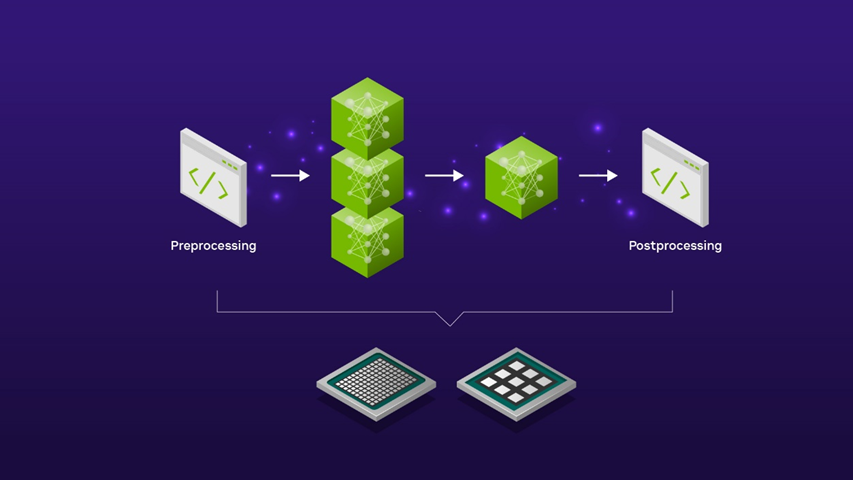
By using Triton Inference Server to serve SDXL models, you can take advantage of the Model Ensembles feature that enables you to define how the output of one model is fed as an input to the next with a low code approach. You can choose to run the pre– and post-processing steps on CPUs and the SDXL model on GPUs or choose to run the entire pipeline on GPUs for ultra-low latency applications. Either option gives you full flexibility and control over the end-to-end latency of your SDXL pipeline.
Efficient scaling for production environments
As more enterprises aim to incorporate SDXL across their lines of business, the challenge of efficiently batching incoming user requests and maximizing GPU utilization becomes increasingly complex. This complexity arises from the need to minimize latency for a positive user experience while simultaneously enhancing throughput to lower operational costs.
The use of an open-source GPU model optimizer like TensorRT, coupled with an inference server with concurrent model execution and dynamic batching capabilities like Triton Inference Server, can alleviate these challenges.
Consider, for instance, the scenario of running an SDXL model in parallel with other TensorFlow and PyTorch image classification or feature extraction AI models, particularly in a production environment with a high volume of incoming client requests. Here, the SDXL model can be compiled with TensorRT, which optimizes the model for low-latency inference.
Triton Inference Server can also efficiently batch and distribute the high volume of incoming requests across the models, regardless of their backend frameworks, through its dynamic batching and concurrent inferencing capability. This approach optimizes throughput, enabling enterprises to meet user requirements with fewer resources and lower total cost of ownership.

Turning plain product photos into beautiful marketing assets
A good example of a company harnessing the power of the NVIDIA AI Inference Platform to serve SDXL in production environments is Let’s Enhance. This pioneering AI startup has been using Triton Inference Server to deploy over 30 AI models on NVIDIA Tensor Core GPUs for over 3 years.
Recently, Let’s Enhance celebrated the launch of their latest product, AI Photoshoot, which uses the SDXL model to transform plain product photos into beautiful visual assets for e-commerce websites and marketing campaigns.
With Triton Inference Server’s robust support for various frameworks and backends, coupled with its dynamic batching feature set, Vlad Pranskevichus, Let’s Enhance Founder and CTO, was able to seamlessly integrate the SDXL model into existing AI pipelines with minimal involvement from the ML Engineering teams, freeing up their time for research and development efforts.
Through a successful proof of concept, the AI image enhancement startup identified a 30% reduction in costs by migrating their SDXL models to NVIDIA L4 GPUs on Google Cloud G2 instances and has outlined a roadmap to complete the migration of several pipelines by mid-2024.

Getting started with SDXL using L4 GPUs and TensorRT
In this next section, we demonstrate how you can quickly deploy a TensorRT-optimized version of SDXL on Google Cloud’s G2 instances for the best price performance. To spin up a VM instance on Google Cloud with NVIDIA drivers, follow these steps.
Choose the following machine configuration options:
- Machine type: g2-standard-8
- CPU platform: Intel Cascade Lake
- Minimum CPU platform: None
- Display device: Disabled
- GPUs: 1 x NVIDIA L4
The g2-standard-8 machine type features one NVIDIA L4 GPU and four vCPUs. Larger machine types are available depending on how much memory is required.
Choose the following boot disk options, making sure that the source image is selected:
- Type: Balanced persistent disk
- Size: 500 GB
- Zone: us-central1-a
- Labels: None
- In use by: instance-1
- Snapshot schedule: None
- Source image: c0-deeplearning-common-gpu
- Encryption type: Google-managed
- Consistency group: None
The Google Deep Learning VM includes the latest NVIDIA GPU libraries.
After the VM instance is up and running, in a browser window, choose Connect, SSH, Open, and authenticate. This loads an SSH terminal in a browser window.
Use the following steps to generate images using Stable Diffusion XL optimized using TensorRT.
Clone the TensorRT OSS repository:
git clone https://github.com/NVIDIA/TensorRT.git -b release/9.2 --single-branch
cd TensorRT
Install nvidia-docker and launch the PyTorch container:
docker run --rm -it --gpus all -v $PWD:/workspace nvcr.io/nvidia/pytorch:24.01-py3 /bin/bash
Install the latest TensorRT release:
python3 -m pip install --upgrade pip
python3 -m pip install --pre --upgrade --extra-index-url https://pypi.nvidia.com tensorrt
Install the required packages:
export TRT_OSSPATH=/workspace
export HF_TOKEN=<your_hf_token_to_download_models>
cd $TRT_OSSPATH/demo/Diffusion
pip3 install -r requirements.txt
Now run the TensorRT-optimized Stable Diffusion XL model, with a prompt of “art deco, realistic”:
python3 demo_txt2img_xl.py "art deco, realistic" --hf-token=$HF_TOKEN --version xl-1.0 --batch-size 1 --build-static-batch --num-warmup-runs 5 --seed 3 --verbose --use-cuda-graph
This generates a stunning image that can be viewed in a notebook:
from IPython.display import display
from PIL import Image
img = Image.open('output/xl_base-fp16-art_deco,_-1-xxxx.png')
display(img)

Congratulations! You’ve generated a sample image using Stable Diffusion XL optimized with TensorRT.
To boost throughput, you can use a larger machine type leveraging up to 8 x L4 GPUs and load the model on each GPU for efficient parallel processing. For even faster inference, you can adjust the number of denoising steps, image resolution, or precision. For example, dropping the number of denoising steps from 30 to 20 in the earlier example boosts throughput by 1.5x images/second.
The L4 GPU excels in price-performance. It generates 1.4x more images per dollar compared to the NVIDIA A100 Tensor Core GPU, making it ideal for cost-sensitive applications and offline batch image generation. However, relative to L4, the A100 or H100 is the better choice for latency-sensitive applications, generating images 3.8-7.9x faster, respectively.
Performance depends on several factors during inference, including batch size, resolution, denoising steps, and data precision. For more information about further optimizations and configuration options, see the DemoDiffusion example in the /NVIDIA/TensorRT GitHub repo.
Deploying SDXL in production with Triton Inference Server
Here’s how you can deploy SDXL models in production with Triton Inference Server on a g2-standard-32 machine type.
Clone the Triton Inference Server Tutorials repository:
git clone https://github.com/triton-inference-server/tutorials.git -b r24.02 --single-branch
cd tutorials/Popular_Models_Guide/StableDiffusion
Build the Triton Inference Server diffusion container image:
./build.sh
Run an interactive shell in the container image. The following command starts a container and volume mounts the current directory as a workspace:
./run.sh
Build the Stable Diffusion XL TensorRT engines. It takes a few minutes.
./scripts/build_models.sh --model stable_diffusion_xl
When it’s complete, the expected output will look like the following:
diffusion-models
|-- stable_diffusion_xl
|-- 1
| |-- xl-1.0-engine-batch-size-1
| |-- xl-1.0-onnx
| `-- xl-1.0-pytorch_model
`-- config.pbtxt
Start Triton Inference Server. In this demo, we use the EXPLICIT model control mode to control which Stable Diffusion version is loaded. For more information about production deployments, see Secure Deployment Considerations.
tritonserver --model-repository diffusion-models --model-control-mode explicit --load-model stable_diffusion_xl
When it’s complete, the expected output will look like the following:
<SNIP>
I0229 20:22:22.912465 1440 server.cc:676]
+---------------------+---------+--------+
| Model | Version | Status |
+---------------------+---------+--------+
| stable_diffusion_xl | 1 | READY |
+---------------------+---------+--------+
<SNIP>/sy
In a separate interactive shell start a new container to run the sample Triton Inference Server client. The following command starts a container and volume mounts the current directory as a workspace:
./run.sh
Send the prompt to Stable Diffusion XL:
python3 client.py --model stable_diffusion_xl --prompt "butterfly in new york, 4k, realistic" --save-image

Congratulations! You’ve successfully deployed SDXL with Triton.
Dynamic batching with Triton Inference Server
After you’ve gotten the basic Triton Inference Server up and running, you can now increase the max_batch_size parameter to enable dynamic batching.
Stop Triton Inference Server if it is running. The server can be stopped by entering CTRL-C in the interactive shell.
Edit the model configuration file, ./diffusion-models/stable_diffusion_xl/config.pbtxt, to increase the batch size to 2:
- Before:
max_batch_size: 1 - After:
max_batch_size: 2
Rebuild the TRT engines for a batch size of 2. It takes a few minutes.
./scripts/build_models.sh --model stable_diffusion_xl
When it’s complete, the expected output will look like the following:
diffusion-models
|-- stable_diffusion_xl
|-- 1
| |-- xl-1.0-engine-batch-size-2
| |-- xl-1.0-onnx
| `-- xl-1.0-pytorch_model
`-- config.pbtxt
Restart Triton Inference Server:
tritonserver --model-repository diffusion-models --model-control-mode explicit --load-model stable_diffusion_xl
When it’s complete, the expected output will look like the following:
<SNIP>
I0229 20:22:22.912465 1440 server.cc:676]
+---------------------+---------+--------+
| Model | Version | Status |
+---------------------+---------+--------+
| stable_diffusion_xl | 1 | READY |
+---------------------+---------+--------+
<SNIP>
Send concurrent requests to the server. For the server to dynamically batch multiple requests, there must be multiple clients sending requests in parallel. The sample client enables you to increase the number of clients to see the benefits of dynamic batching.
python3 client.py --model stable_diffusion_xl --prompt "butterfly in new york, 4k, realistic" --clients 2 –requests 5
Examine the server log and metrics. With dynamic batching enabled, concurrent requests, and info-level logging, the example prints out additional information about the number of prompts included in each request to the TensorRT engines.
57291 │ I0229 20:36:23.017339 2146 model.py:184] Client Requests in Batch:2
57292 │ I0229 20:36:23.017428 2146 model.py:185] Prompts in Batch:2


Summary
Deploying SDXL on the NVIDIA AI Inference platform provides enterprises with a scalable, reliable, and cost-effective solution.
Both TensorRT and Triton Inference Server can unlock performance and simplify production-ready deployments and are included as a part of NVIDIA AI Enterprise available on the Google Cloud Marketplace. AI Enterprise features NVIDIA support services along with enterprise-grade stability, security, and manageability for open-sourced containers and frameworks that support AI inference.
Enterprise developers can also choose to train, fine-tune, optimize, and infer diffusion foundation models with NVIDIA Picasso, a foundry for custom generative AI for visual content.
SDXL is available as a part of NVIDIA AI Foundation Models and on the NGC catalog. which offers an easy-to-use interface to quickly try SDXL directly from your browser.
Learn more about how NVIDIA can power the diffusion model inference pipeline at NVIDIA GTC 2024:

